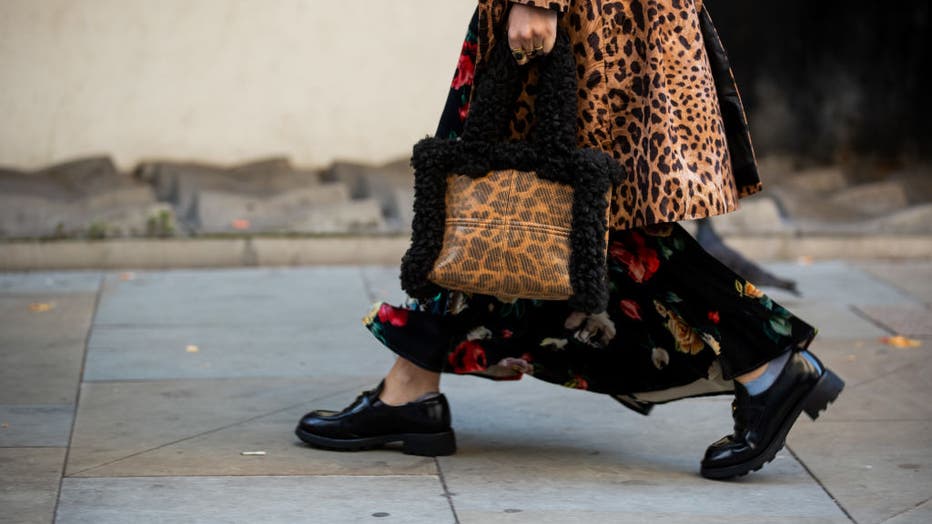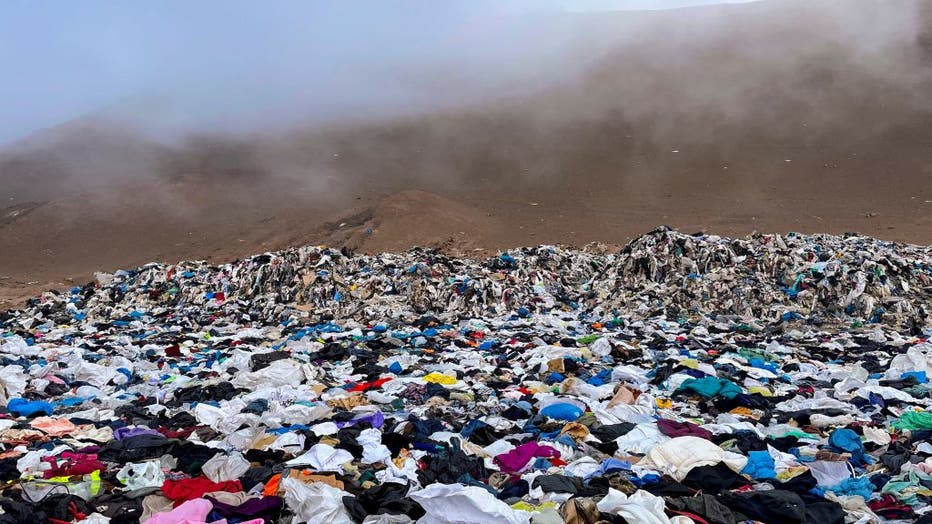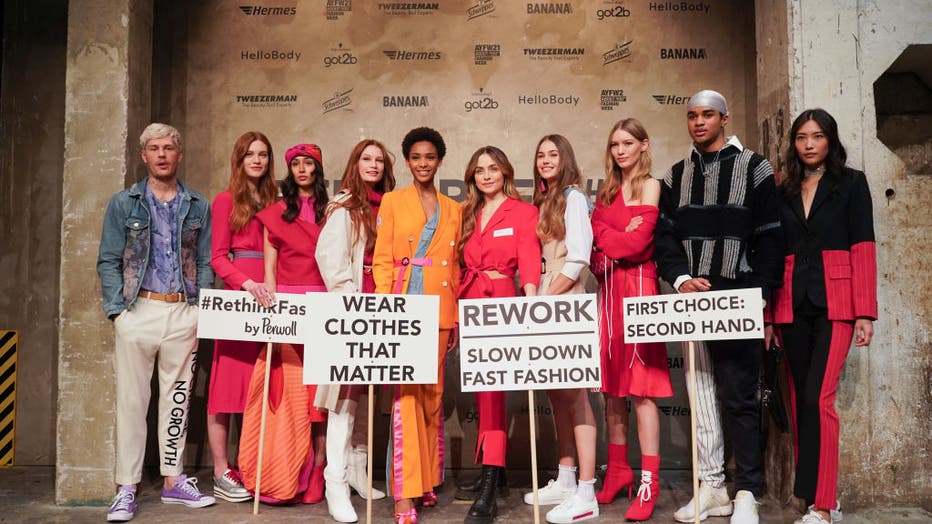The price of fast fashion: How quick trends, 'throwaway culture' harm the planet
How fast fashion impacts the environment
Akhil Sivanandan co-founded Green Story, a platform to measure and communicate the environmental impact of products. He shares the negative aspects of fast fashion on our planet.
The fashion industry has changed drastically over the years. Retailers who once ran on two major seasons — fall/winter and spring/summer — now put out new trends throughout the year at breakneck speed.
Popular brands in the so-called "fast fashion" world, such as Zara, H&M, Forever 21, Fashion Nova and Shein, allow consumers to hop on trends quickly and affordably. But experts say this convenience also comes at a cost.
"It’s cheap to get, and it’s as many seasons as you want. That’s what makes fast fashion in that sense dangerous because it’s promoting hyper-consumerism," said Akhil Sivanandan, co-founder and CEO of Green Story, a startup that uses data to measure and help show consumers the environmental impact of products.
The average number of clothing garments purchased per person between 2000 and 2014 increased by about 60%, while people kept their clothing items about half as long, according to insights from research and consulting firm McKinsey & Company. It added that estimates have also suggested consumers treat the lowest-priced garments as nearly disposable, discarding them after just seven or eight wears.
Meanwhile, social media makes it easier for people to see things they didn’t know they needed — i.e. being "influenced." Platforms like Instagram and TikTok even allow people to buy items in the app without ever having to reach for their wallet.

FILE - A woman uses her smartphone in Beijing on Nov. 11, 2017. (Photo credit: FRED DUFOUR/AFP via Getty Images)
Over time, fast fashion has grown into a larger, more streamlined business with numerous environmental and social impacts, according to experts. Making clothes requires high usage of water and chemicals, production emits a significant amount of greenhouse gases into the atmosphere, while many clothing-factory workers are underpaid in reported unsafe working conditions.
Fast fashion definition and its evolution
Merriam-Webster defines fast fashion as "an approach to the design, creation, and marketing of clothing fashions that emphasizes making fashion trends quickly and cheaply available to consumers."
Over time, consumers’ demands for immediacy have increased and production cycles have gotten quicker. Zara is often credited with being among the first to pioneer the fast fashion business model and in the past has introduced more than 20 different collections a year, according to a 2020 report by Vox.
Meanwhile, online retailers like Shein, Fashion Nova and Missguided have turned fast fashion into "ultra-fast fashion." Missguided has released about 1,000 new products monthly in the past, according to a 2017 report by Coresight Research. Fashion Nova — known to some as an "Instagram brand" for its ubiquity on the platform — launches about 600 new items each week, its CEO said in a 2018 interview.
"It’s important to have a lot of styles because our customers post so much online and need new clothes. We don’t want girls showing up to the club in the same outfit. We need 50 different denim jackets. Not just one," Fashion Nova CEO and founder Richard Saghian told Women's Wear Daily that year.
And other research suggests he’s right about consumer behavior, particularly the desire to never repeat an #OOTD (outfit of the day) on visual platforms like Instagram. A 2017 poll commissioned by Hubbub, a London-based environmental charity, found that 41% of all 18 to 25-year-old's felt pressure to wear a different outfit every time they went out. One in six young people said they didn’t feel they could wear an outfit again once it’s been on social media.
With online shopping available 24/7, impulse buying and returning items has become easier and easier.
"It’s kind of really changing the game where they're using very specific human behavioral nudges to push people toward buying more clothes," Sivanandan said. "What's happening then, is that if you can buy a shirt for $5 you're just going to keep buying them because it's easy. You're not feeling the cost of it, the real cost."

FILE - A person is seen wearing animal print with a matching bag during London Fashion Week on Sept. 17, 2021, 2021 in London, England. (Photo by Christian Vierig/Getty Images)
Globally, 80 billion pieces of new clothing are purchased each year, translating to $1.2 trillion annually for the global fashion industry, according to a 2018 study, which noted how the majority of products are assembled in China and Bangladesh while the U.S. consumes more clothing and textiles than any other nation.
The world is on track to triple clothing production by 2050, according to a report from the American Chemical Society on how to make fashion more sustainable.
Environmental impacts of fast fashion
Any product a person buys has three impacts that come with it, Sivanandan said: "One is the impact of getting to you, the manufacturing, transportation, all of those things. Second is your own usage of it, and the third is the discard factor, how do you get rid of it?"
The fashion industry produces between 2% to 8% of global carbon emissions, according to the United Nations Environment Programme — while other more recent figures have estimated 8%-10%. It also consumes a large amount of water, requiring around 2,000 gallons to make a typical pair of jeans.
Meanwhile, textile dyeing is also the second-largest polluter of water globally, the UN program says. As many experts have pointed out, factories moving overseas may be in countries without strict environmental regulations — resulting in untreated water entering the world’s oceans.
Textiles are also estimated to account for approximately 9% of annual microplastic losses to the ocean.
Sivanandan noted how cheaply-made clothing is easily discarded after being worn only a few times.
"You can just buy a new item at the same price as repairing it, so why spend $80 on repairing a pair of sneakers when a new pair costs exactly the same," he said. "It’s a throwaway culture."
Many fast fashion casualties have ended up in places like Chile's Atacama desert, where some 39,000 tons of discarded clothing have amassed, according to a 2021 report by the Agence France-Presse.

FILE - View of used clothes discarded in the Atacama desert, in Alto Hospicio, Iquique, Chile, on Sept. 26, 2021. (Photo by MARTIN BERNETTI/AFP via Getty Images)
The amount of textile that has ended up in a landfill in the U.S. has increased over the past 60 years, going from 1.7 million tons in 1960 to 11.3 million tons in 2018, data from the Environmental Protection Agency shows.
Because fast fashion is cheap, it’s also led to various social impacts for those in the labor force in countries where regulations aren’t as strict. Workers often live in areas that don’t have places to recycle, or near waterways polluted by the chemicals from textile dyeing.
A 2019 report from Oxfam found that 100% of surveyed workers in Bangladesh and 74% workers in Vietnam are paid below living wages — or in other words, the lowest wage paid to a full-time worker that covers the essential basics, as well as some savings for the future and unexpected events.
Ways to make your wardrobe more sustainable
The awareness of the fast fashion business model has grown amid a heightened demand from consumers for more sustainable practices. Google search trends highlights some concerns, showing related search queries like, "is Fashion Nova fast fashion" or "the ugly truth of fast fashion."
And more retailers are listening.
"Consumers want to know where materials come from, how products are made, and whether the people involved are treated fairly," a State of Fashion 2022 report from McKinsey & Company states. "In response, more and more companies are expanding their sustainable assortments and working to boost the sustainability of their supply chains."

FILE - Models show creations as part of Perwoll's "Rethink Fashion" show at About You Fashion Week at Kraftwerk Berlin in Germany, holding signs criticizing fast fashion. (Photo by Jörg Carstensen/picture alliance via Getty Images)
There are ways that individuals can try and make their fashion choices more sustainable. First off, ask yourself next time you’re moving something to an online shopping cart: "Do I really need this?"
Other suggestions from experts include:
1) Buy secondhand or vintage. Companies like Rent the Runway or Nuuly even allow you to rent clothing. When getting rid of old clothes, sell them on sites like Poshmark or ThredUp, donate them, or pass them on to someone else who will wear them. While you’re at it, ThredUp has an online calculator that lets people calculate their fashion footprint.
2) Do research on where and how to spend your money. Buy clothing from sustainable brands that are transparent about their supply chains. Consumers can check the Fashion Transparency Index to see how many companies rank in transparency.
3) Wear clothing longer and learn how to take care of items so they withstand the test of time, which can include washing items less and taking them to be repaired. Some may even upcycle their unwanted clothes into something new.
Consumers have the power to create change, Sivanandan says — and small differences can have a large impact over time.
"The reason fast fashion has taken off so well is it’s a positive feedback loop," he explained. "Somebody out there tried fast fashion. They really pushed it and said, ‘Okay, will this take off? Will consumers want to buy $10 cheap items? And they did, and it’s become huge. Same thing can happen in reverse."
This story was reported from Cincinnati.

